This is a controversial topic among speech therapists but not among speech researchers! Oral motor speech therapy is divided into speech oral motor therapy, researched backed, and non-speech oral motor therapy- pure non-sense. Let’s start with the term oral motor, which is an ambiguous term to begin with. Speech sound disorders (articulation and phonological disorders) is the up-to-date nomenclature. Speech therapists, who incorporate non-speech oral motor techniques, learn about them at professional trainings, post graduation, when trends are prioritized over science. The content of these professional trainings are not endorsed by ASHA: American Speech Hearing Association. The majority (85% according to Dr. Gregg Lof’s research) of speech therapists use ineffective protocols when diagnosing and/or treating “oral motor” speech problems: pretty scary! Unfortunetly, there is a lack of quality post graduate support in our field.
I have seen so many children misdiagnosed and, as a result, receive ineffective speech treatment. In essence, when working on speech sounds (speech oral-motor), effective therapy always includes the production or shaping of a sound, e.g. close your lips and say “mmm” to teach /m/ or if the child is omitting a final “p” in words, the clinician helps the child say final “p” in short words, e.g. “hop”, “top”, “mop”, etc. Working on sounds, during speech therapy, is natural and a no brainer because it includes facilitating motor planning (agility), mouth strength, and linguistics: all of these underlying neurological processes need to be activated at once- that’s how we speak!
Non-speech oral motor exercises are purported to strengthen muscles and/or improve muscle tone, including blowing whistles, sucking straws, and chewing on chewy tubes. It does not involve working on actual sounds. It may improve general oral mouth muscle/tone but there is NO scientific evidence that it actually improves speech. Yep, none! Our mouths are used for a variety of functions, e.g. breathing, drinking, chewing, swallowing, etc. The more you know about the science of speech therapy, the more this makes sense.
Speech is special! We actually use minimal muscle strength to talk. Tone is important when the speech muscles are at rest. Strength is important for chewing, not talking. Speech learning is primarily based on agility (motor planning, think of a ventriloquist) and cognition and linguistic- all brain based! Other animals vocalize but can’t talk; the differences reside in our brains, not our mouths! That’s the beauty of evolution.
An analogy, for example, would be to perform finger strength exercises to become a better piano player. Strong fingers and lack of actual piano practice is the equivalent of non-speech oral motor therapy. Would you hire a piano teacher to work only on strengthening your child’s finger muscles Non-speech oral motor techniques have nothing to do with speaking, e.g. chewing on chewy tubes, moving your articulators in ways in which we don’t speak, drinking from special straws, etc. Speech scientists strongly advise that speech therapists focus on techniques that facilitate shaping and/or producing sounds for a given language.
To quote an excerpt from a Letter to the Editor, from the NY Times (1/24/12), the following sums up what happens in the therapy world, no matter what profession:
“We frequently receive manuscripts in which people promote ideas and theories without adequate data, usually in pursuit of personal fame or monetary gain. Although the peer-reviewed medical literature is not without flaws, there is no better way than peer review to vet information before it is used in the diagnosis and treatment of disease. At least in medicine, we should think carefully before we decide that more, unfiltered information is better information.”
-Jeffrey M. Drazen, M.D.
The writer is editor in chief, The New England Journal of Medicine.
- Does Oral-Motor Therapy Really Work by Isaa Marrs – (SpeechLanguageFeeding.com: The Resource for Parents and Professionals)
Oral Motor Therapy by Dr. Caroline Bowen
Logic, Theory and Evidence Against the Use of Non-Speech Oral Motor Exercises to Change Speech Sound Production (An Interview with Gregory L. Lof, Ph.D., CCC SLP) – (The Childhood Apraxia of Speech Association of North America – CASANA)
The Application of Evidence-Based Practice to Nonspeech Oral Motor Treatments – (American Speech-Language-Hearing Association)
Steps to Identify Pediatric Muscle Weakness and Signs of Neuromuscular Disease (ChildMuscleWeakness.org)
The Problem with Pacifiers (The New York Times)
Is Tongue Strength an Important Influence on Rate of Articulation in Diadochokinetic and Reading Tasks (Journal of Speech Language and Hearing Research)
A Review of Standardized Tests of Nonverbal Oral and Speech Motor Performance (HighBeam Research)
A Meme’s View of Non-Speech Oral Motor Exercises
Controversial Practices – Oral Motor Therapies – readings, abstracts, references
Clinical Decision Making and Oral Motor Treatments
Isolating muscle during speech therapy- it doesn’t really work.
Differential Diagnosis of Severe Speech Impairment in Young Children
Differential Diagnosis of Severe Speech Impairment in Young Children
